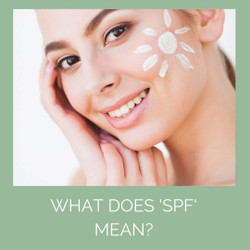
Sun screens with an SPF (sun protection factor) have been around for over 50 years now to help stop us frazzling to a crisp in the sun.
But research since those early days has shown that SPF is only one of 3 essentials in a sunscreen.
Regulations now require sunscreens to provide protection against the UVA part of the spectrum, as this penetrates more deeply into the skin causing premature ageing, wrinkles and cancer.
And recent research confirms that natural botanical antioxidants are also vital to protect against sun damage.
SPF (UVB protection)
What Does SPF Mean?
The Sun Protection Factor is indicative of how well a cream protects us from the sun's UVB rays. Specifically, the SPF tells us is how long after application we need to reapply sun screen to avoid being burned by the sun’s UVB rays. For example, if you normally start to burn after 10 minutes sun exposure, then reapply an SPF 30 after 300 minutes (10 x 30) or 5 hours.
The SPF50 Myth
So the SPF is a guide to exposure time with SPF 50 giving protection from UVB for twice as long as an SPF 25. But, SPF 50 does not give twice the amount of protection against burning as an SPF 25:
SPF25 actually blocks around 96% of the burning UVB rays and SPF 50 around 98%. So put another way, SPF 25 allows 4% of the burning rays through and SPF 50 allows 2% through, a difference of just 2%.
An SPF 30 blocks around 97% of the UVB, so only around 1% less than an SPF 50.
And it takes a significantly higher level of artificial chemicals or whitening minerals to achieve SPF50. So it is somewhat of a myth that nothing less than SPF50 will do - an SPF30 is fine for most people.
UVA protection
What about UVA? A good sunscreen should offer ‘broad spectrum’ protection across the deeper penetrating UVA rays too. In Europe, a sun-cream will show UVA in a circle if it offers broad spectrum protection.
What does SPF mean in relation to the UVA rating?
The higher the SPF, the more UVA protection a sun cream must give. SPF 15-29 is categorised as ‘moderate’, 30-59 is ‘high’ and gives ‘broad spectrum’ UVA and UVB protection.

Antioxidants
Sunlight also accelerates oxidisation and skin ageing by generating free radicals. For this reason, your sun-screen should ideally be boosted by a blend of natural antioxidants to neutralise the damaging effects of free radicals on the skin.
Potent natural antioxidants like beta carotene (pro-vitamin A), vitamin E and polyphenols are found in abundance in organic botanicals such as calendula, rose, sunflower, karanja, sea buckthorn and chamomile.
So you might not need to resort to high SPF sun screen in order to get good sun protection. Make sure you use broad spectrum and if the sun screen itself isn’t antioxidant, use an antioxidant-rich moisturiser as well.
Remember to reapply your sun screen regularly, as well as after bathing or swimming – and remember that applying sun screen sparingly will reduce the SPF.
Whether it’s scorching or not, it also makes sun-sense to seek shade between 12-3pm, wear a wide-brimmed hat and light, loose clothing. A t-shirt equals SPF 30!
Want To Try Our Natural Sunscreen?
More Advice?
If you'd like any more advice on caring for your skin, please do email us –customercare@odylique.co.uk, add your question as a comment below, or call 01638 491022 – we're here to help! Browse our range of summer skincare now.

